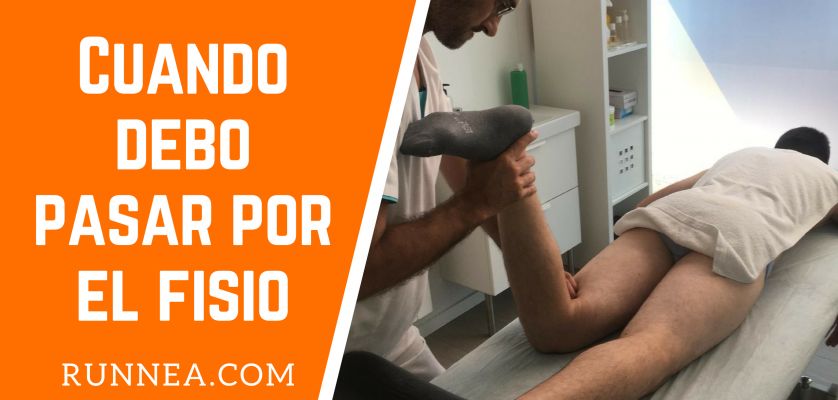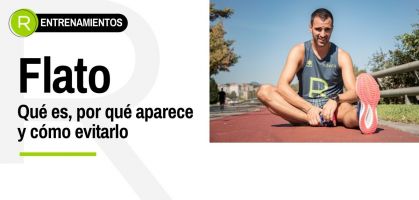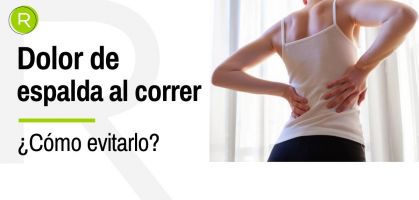When do we go to the physiotherapist? when we are injured? when our legs feel tired? once a month?
If there is something we runners have to take special care of, it is our body. It is our "work" tool and we need to have it always ready, especially if we have a goal in sight. If yours is the Gernika-Bilbao race on October 7, you will have started training to get the best result. Surely you have a good training plan (if you don't have it you can look it up in Academy Win), you are taking care of your diet and getting enough rest. But are you giving your muscles the attention they deserve?
I'm one of those who visit the physio once a month. Loosen up, that's what I ask him to do, to loosen up from my feet to my lower back. When I get up from the stretcher I feel new. We put a lot of kilometers between chest and back and we ask a lot of our body, so the least we can give it is a little attention from time to time.
Today I asked Sergio Blanco Álvarez, physiotherapist at the Kineé Health and Wellness Center, to give us a few tips on how to prepare our body to face a challenge like, for example, running the 34 kilometers that separate Gernika from Bilbao .

Begoña Beristain: The Gernika Bilbao is a race with four distances, from 34 km to 8 km, passing through 22 and 12.
Sergio Blanco. - We must be clear, first of all, that if we want to enjoy the race and prevent any type of overload injury, it is necessary a previous and progressive preparation.
Analyzing well each of the routes and not only taking into account the mileage but also the slope that we must save, including interesting ramps that certainly increases the difficulty of the test, I would recommend the following:
- Dorsal Blanco BASAURI-BILBAO 8,10 kms: suitable for those people who are just starting out in Running, who have been running for about 3 months, going out 3 days a week for about 45 minutes each day, doing about 18-20 kms per week.
- Bronze Dorsal GALDAKAO-BILBAO 12,24kms: runners who have already had experience with short races of 6 to 10kms, who have been running for months or a year, going out 3 times a week, with a duration of 50 to 60 minutes, with variations in pace, running approximately 30-35 kms per week.
- Silver Dorsal ZORNOTZA-BILBAO 21,75kms: a little more than the half marathon, it requires an optimal physical and psychological level since the race will take you to the limit at times. Well-trained runners, used to this distance, who train 5 days a week, 60 minutes long, interspersed with some 90-minute long runs, do series, vary their workouts and include strength, toning and CORE exercises. They do about 60 kms per week.
- Dorsal Oro GERNIKA-BILBAO 35,43 kms: it is not a marathon but it will demand the maximum from the runner. People experienced in a thousand and one races, with a mental strength beyond any doubt. It is essential a good progressive preparation in the medium term, including series, fartlecks, a weekly long run over 90 minutes, strength, toning and CORE exercises.

BB.- Is it advisable that before jumping on the asphalt, runners should take a physical test to see if they can meet this challenge?
SB.- Undoubtedly yes, it would be convenient, it is necessary and I would almost say mandatory, but everyone decides for their own health. Starting with a medical examination, then a stress test and finally a physiotherapeutic evaluation that takes into account the postural study, musculoskeletal balance, shortening and weaknesses, preventive exercises and adaptation of training loads in a progressive manner in order to avoid injuries.
BB.- How should the relationship between a physio and a runner be, is it necessary to go to the stretcher at least once a month, or does it depend on the intensity of the training?
SB.- Our profession as physiotherapists is based on the relationship of trust that is established with the person, in this case with the runner. Trust, especially with athletes, is something that has to be earned. We work and advise the runner looking for the best for him or her, accompanying them to achieve their goals, prevent injuries or helping them to recover.
The frequency of treatments varies depending on the runner's level, goals, injury history, the time of the season we are in ... to recommend a normal routine would be once a month to go through the hands of a physiotherapist and go adapting the appointments depending on the needs and their evolution.
BB.- What are the most common injuries of a runner?
SB.- As it is an impact sport, the most common injuries are those caused by overloading the joints and muscles-tendons of the lower extremity. To name with high prevalence appear from ankle sprains to Achilles tendinopathies that affect the Achilles tendon and that are disabling, preventing the practice of sports. In the knee, patellar tendinopathy and the involvement of the iliotibial band that gives rise to the so-called "runner's knee". In the hip, contractures of the adductor musculature and pyramidal muscle that sometimes cause sensations of false sciatica when the pain radiates below the buttock. And we cannot forget the dreaded plantar fasciitis characterized by an inflammation-degeneration of the fascial membrane that covers the tendons and muscles of the sole of the foot.
BB: What argument would you use to convince someone who runs that it is necessary to rest from time to time or that when injured it is better not to force?
SB: That's a very good question because it's the battle we fight every day with runners who are convinced that their improvement lies in the number of hours of training. This is not the case.
Nowadays it has become clear under physical performance studies that what is really important is not quantity but quality, hence we are starting to train more and more with HIIT "American definition of High Intensity Interval Training".
But the crushing argument comes when you talk to them about INVISIBLE TRAINING.
I think the most important thing is to explain to the runner that the improvement in physical performance consists of more factors than purely training, training, training and you have to take care of all of them, from a balanced diet that provides and replenishes the nutrients necessary for the body to function at optimal levels as a correct rest, a dosage of training that includes recovery periods, rest phases to ensure a restful sleep 7 hours a day minimum essential for the assimilation of loads and muscle anabolic effect.
Listen to your physio and he will take care of you".
BB.- There is a lot of controversy about stretching. What importance do you give to it? Do you recommend doing them before or after training?

SB.- Stretching plays an important role in the physical conditioning of the runner. Not only in injury prevention but also in getting the athlete in shape. I would go so far as to say that everyone should at least perform movements that stretch the muscles.
Stretching should occupy an important part of the weekly training session planned for active recovery, loosen legs and stretch. Not only as it is being done 5 minutes at the end and quickly to the shower.
NEVER, NEVER stretch cold, or start a session with stretching. The first thing to do before anything else are soft dynamic exercises for warming up and progressive activation. Once this first phase is finished, you can do some stretching exercises prior to intense exercise. Finally, stretch gently, trying to find global stretches that cover more than one muscle group at the same time.
After a race, an intense workout, the fatigued musculature does not want or need to be pounded with strong stretching, now is not the time, this is not the right moment, better to let your legs loose in the pool or do some static cycling without resistance.
BB: How should we recover after a demanding race like the Gernika - Bilbao?
SB.- If we talk about recovery, we should know that it starts right after finishing the race with what we call "anabolic window" and includes the 45 minutes after finishing the race.
It is very important that we rehydrate well by providing water, mineral salts (sodium, potassium, magnesium, calcium) in the form of isotonic drinks and a complex of carbohydrates with amino acids to help stop muscle catabolism and wear after the race. Drainage, circulatory and unloading massages followed by a bath (jacuzzi) to loosen legs is very good the days after the race. Generally, fatigue and tiredness is greater 48 hours after the race than the next day, so it is advisable not to stop completely and to do gentle active recovery exercise such as exercise bike, swimming pool, gentle jogging the week after the race.
Start training again progressively depending on how you feel.
BB.- What does running mean for our body? Is it too aggressive a sport?
SB.- Running as a sport offers us good things, very good things and others that are not so good. If we are aware of this, we can limit the consequences that an excess or a bad practice can have on our health.
It is obvious that exercise is necessary for human beings, in fact if we look at it from an evolutionary point of view, running, jumping and climbing era essential for our ancestors, the first hominids, if they wanted to survive. It brings us countless benefits both physically, musculoskeletal, cardiovascular, metabolic, psychological ... but has a number of implicit side effects. running, being an impact sport that generates continuous microtrauma to our body, can cause accelerated wear of the articular cartilage in joints such as the hip, knee and ankle and consequences at the lumbar spine level. In the medium term, this is what is known as osteoarthritis.
We also know that exercise practiced intensely and without control causes cardiac hypertrophy, i.e. the heart becomes larger to pump more blood, this can be a benefit in young people and adults in the years to come and in older people who stop practicing sport or no longer do it with that intensity becomes a heart failure, large heart, dilated but no longer has that stimulus or the need to contract as it did before. With the fever that has been uncovered with running these years and the number of people who start running without the correct preparation, it is possible that in the future we will see the consequences.
BB.-Is there any kind of injury that will prevent you from running forever or is it a matter of knowing how you step?
SB.- Yes, yes, there are injuries that can remove you from running for life as back injuries, hip, knee ... we are talking about serious injuries, disabling, traumatic or others that are diagnosed after years of evolution and where it is recommended to stop running to avoid greater evils.
Thank God there are fewer cases and nowadays with the training of the professionals we have, the technical and material means we have, a person who is going to run only has to be well informed, put himself in good hands to advise him on training, prevention exercises and the purchase of material, shoes according to his footprint, etc.
BB.-Is it essential to have a physio if you run on a regular basis?
SB.- Ufffff ... what can I tell you ... of course it is!
No, seriously, it is not fundamental. Interesting, convenient and it can help you a lot, yes.
BB.- Any recommendation for the Gernika -Bilbao route?
SB.- In addition to what I have already mentioned, I would like to highlight three things:
- It is a race that has some slope, which has hills, so when preparing for it, do some sessions including running uphill.
- Vary your workouts, in pace, duration, route and include strength and toning exercises giving special importance to the CORE. If not, you will not improve.
- If you want to enjoy the race plan your workouts with time and remember:
Running the race is not the hard part, it's time to enjoy it, the hard part has been preparing for it."
Read more news about: Sports Injuries



























